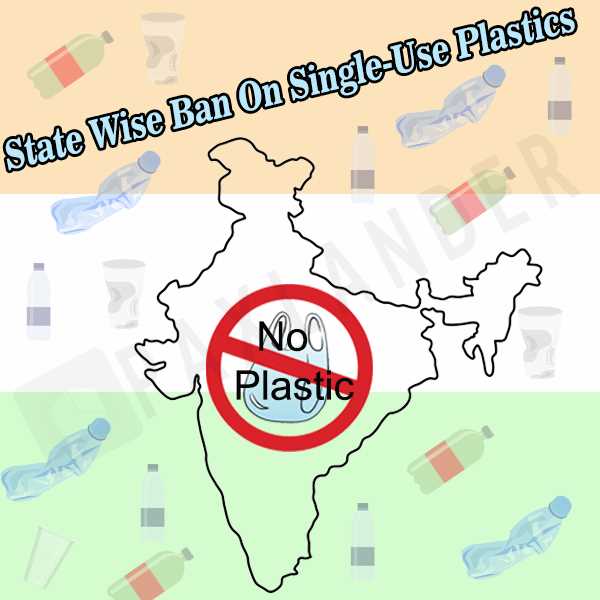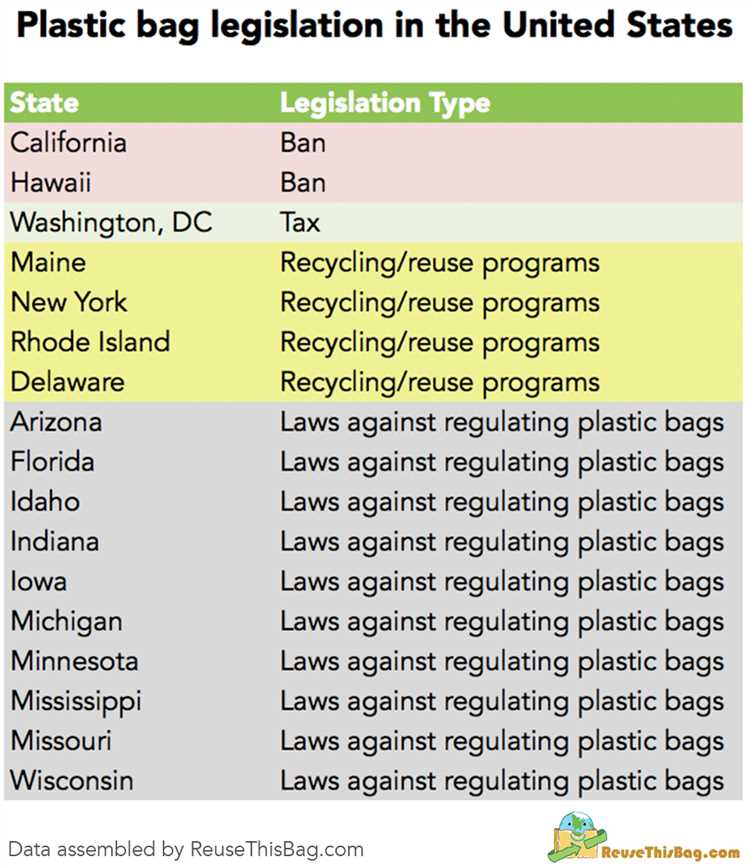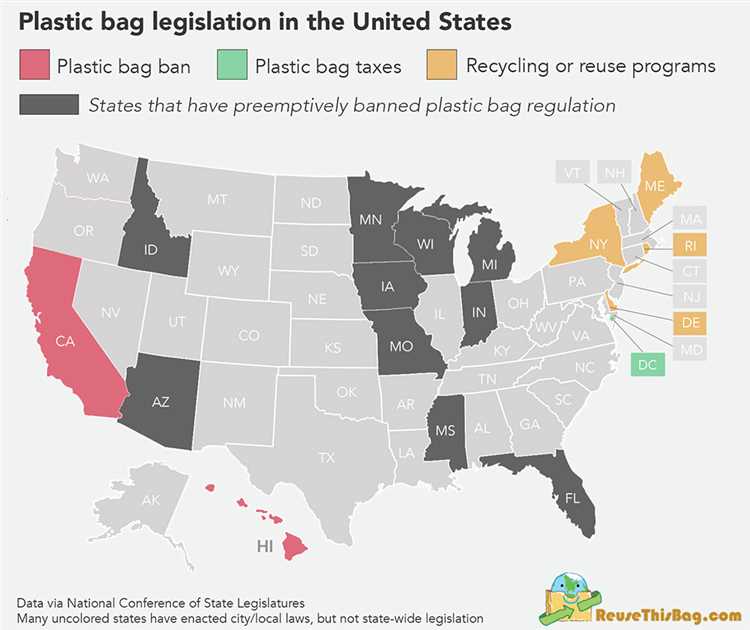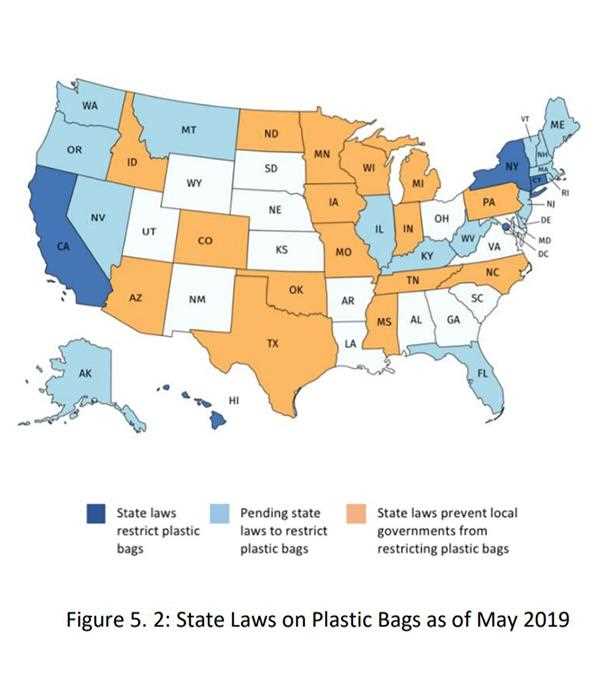
The world’s growing reliance on single-use plastics has become a global environmental crisis. These plastic items, such as bags, straws, and cutlery, contribute to pollution and pose a significant threat to marine life. To combat this issue, several states in the United States have implemented complete plastic bans, leading the way for sustainable practices and environmental protection.
One state that stands out as a leader in the fight against plastic pollution is California. In 2016, California became the first state in the U.S. to ban single-use plastic bags. This bold step was a gamechanger, not only for California but also for other states looking to follow suit. California’s ban on plastic bags has significantly reduced the consumption of single-use plastics and has set an example for other states to adopt more sustainable alternatives.
Another state making strides in the battle against plastic waste is Hawaii. With its pristine beaches and abundant marine life, Hawaii has recognized the urgent need to protect its fragile ecosystems. In 2018, Hawaii passed a comprehensive law banning single-use plastic bags, polystyrene foam containers, and plastic utensils. This ban has helped to preserve the natural beauty of the islands and promote eco-friendly alternatives.
Seattle, Washington, is also paving the way towards a plastic-free future. In 2012, Seattle became the first major city in the U.S. to ban plastic bags. The ban was later expanded to include all single-use plastic food service items, such as straws and utensils, in 2018. Seattle’s proactive approach to reducing plastic waste has not only protected the local environment but has also inspired other cities across the country to take similar actions.
As more states recognize the urgent need to address plastic pollution, the movement towards complete plastic bans continues to gain momentum. By implementing these bans, states are not only protecting their own environments but also setting a precedence for sustainability and inspiring others to follow in their footsteps. With California, Hawaii, and Seattle leading the way, it is clear that the fight against plastic waste is gradually being won, one state at a time.
- States with a Complete Plastic Ban
- Understanding the Impact of Plastic Pollution
- 1. Environmental Impact
- 2. Human Health Implications
- 3. Economic Impact
- The Need for a Complete Plastic Ban
- Economic Impact
- Setting an Example
- Leading the Way: The State That Set the Example
- Examining Successful Plastic Ban Policies
- 1. Strong Legislative Measures
- 2. Comprehensive Approach
- 3. Collaboration and Cooperation
- Challenges and Successes in Implementing Plastic Bans
- Challenges:
- Successes:
- Sustainable Alternatives to Plastic
- 1. Paper
- 2. Glass
- 3. Metal
- 4. Biodegradable Plastics
- 5. Plant-Based Alternatives
- Q&A:
- Which states in the US have a complete plastic ban?
- What is the purpose of a plastic ban?
- How do these states enforce the plastic ban?
- Are all types of plastic banned in these states?
- How effective have these plastic bans been in reducing plastic waste?
- Which states in the US have a complete plastic ban?
- What are some of the measures taken by these states to ban plastic?
States with a Complete Plastic Ban
Plastic pollution has become a global environmental crisis, and many countries and states are taking action to address this issue. Several states in the United States have implemented a complete plastic ban to reduce the use of single-use plastics and promote sustainable alternatives. These states have recognized the urgent need to curb plastic waste and have implemented strict regulations to achieve this goal.
One state leading the way in the complete plastic ban is California. In 2016, California became the first U.S. state to ban single-use plastic bags. The ban applies to most grocery stores, convenience stores, and pharmacies, and encourages the use of reusable bags instead. California has also implemented a ban on polystyrene foam food containers and has restricted the use of plastic straws in restaurants.
Another state that has implemented a comprehensive plastic ban is Hawaii. Hawaii has banned single-use plastic bags statewide since 2015, making it one of the earliest adopters of such a ban in the U.S. The state has also banned polystyrene foam containers and utensils, as well as plastic straws and utensils.
Washington is also making strides towards a complete plastic ban. The state has banned single-use plastic bags, and several cities have implemented their own bans on plastic straws and utensils. Additionally, Washington restricts the use of polystyrene foam containers in food service establishments.
Oregon is another state that has taken measures to reduce plastic waste. The state has banned single-use plastic bags and has implemented a ban on polystyrene foam containers. Oregon has also introduced legislation to restrict the use of plastic straws, although this ban has not been fully implemented yet.
These states are setting an example for the rest of the country by taking proactive measures to reduce plastic waste. By implementing complete plastic bans, these states are promoting environmental sustainability and encouraging the use of more eco-friendly alternatives. It is essential for other states and countries to follow suit and take similar actions to combat the plastic pollution crisis.
| State | Date of Plastic Ban Implementation | Banned Items |
|---|---|---|
| California | 2016 | Single-use plastic bags, polystyrene foam food containers, plastic straws |
| Hawaii | 2015 | Single-use plastic bags, polystyrene foam containers and utensils, plastic straws and utensils |
| Washington | Varying dates | Single-use plastic bags, polystyrene foam containers, plastic straws and utensils (depending on city) |
| Oregon | Various dates | Single-use plastic bags, polystyrene foam containers, plastic straws (upcoming) |
Understanding the Impact of Plastic Pollution
Plastic pollution is a growing environmental crisis that has serious consequences for our planet. The overuse and improper disposal of plastic products have led to widespread contamination of our oceans, rivers, and land. Understanding the impact of plastic pollution is crucial in order to address this issue effectively.
1. Environmental Impact
Plastic pollution poses a significant threat to the environment. Marine animals, such as turtles, dolphins, and seabirds, often mistake plastic waste for food and end up choking on it or getting entangled in it. This leads to injury and death, disrupting the fragile balance of ecosystems.
The presence of plastic debris in our oceans also has a negative impact on coral reefs. Plastic can smother coral and prevent it from receiving light and nutrients, leading to coral bleaching and eventual death.
2. Human Health Implications

Plastic pollution not only harms the environment, but it also has implications for human health. When plastic breaks down into tiny particles called microplastics, they can enter the food chain and contaminate the fish and seafood that we consume.
The ingestion of microplastics has been linked to various health problems, including hormonal imbalances, reproductive issues, and an increased risk of certain types of cancer. Furthermore, the chemicals used in the production of plastic, such as bisphenol A (BPA), have been found to leach out and can be toxic to humans.
3. Economic Impact
Plastic pollution also has significant economic consequences. The cleanup and removal of plastic waste from our environment require substantial resources and funding. Additionally, the tourism and fishing industries can suffer as a result of polluted beaches and waters, impacting local economies.
Moreover, the production and disposal of plastic involve energy-intensive processes, contributing to greenhouse gas emissions and exacerbating climate change.
In conclusion, plastic pollution has a devastating impact on the environment, human health, and the economy. It is imperative that we take action to reduce plastic consumption, improve waste management systems, and implement policies that promote the use of sustainable alternatives to plastic.
The Need for a Complete Plastic Ban
Plastic pollution has become one of the most pressing environmental issues of our time. The proliferation of single-use plastics and the improper disposal of plastic waste have led to devastating consequences for both human health and the natural world. As a result, many states have recognized the need for a complete plastic ban to address this urgent problem.
First and foremost, a complete plastic ban is necessary to protect marine life and ecosystems. Plastic waste, particularly plastic bags and microplastics, find their way into the oceans and waterways, where they pose a significant threat to marine animals. Marine creatures often mistake plastic for food, leading to ingestion and entanglement, both of which can be fatal. Additionally, plastic pollution disrupts fragile ecosystems and contributes to biodiversity loss.
Furthermore, a complete plastic ban is essential for safeguarding human health. Plastics contain harmful chemicals, such as bisphenol A (BPA) and phthalates, which can leach into food and beverages. These chemicals have been linked to various health issues, including hormonal disruption, reproductive problems, and certain types of cancer. By eliminating plastics from our daily lives, we can reduce our exposure to these toxic substances and protect our well-being.
Economic Impact

In addition to its environmental and health benefits, a complete plastic ban can have positive economic effects. By reducing our dependence on plastic, we can promote the development of alternative materials and industries. This shift towards more sustainable options can create new jobs and stimulate innovation, ultimately driving economic growth. Moreover, the cost of managing plastic waste is a significant burden on local governments and taxpayers. By implementing a plastic ban, states can reduce the costs associated with waste management and allocate resources more efficiently.
Setting an Example
States that enact complete plastic bans also serve as a model for other regions and countries. By taking a proactive stance on plastic pollution, these states demonstrate their commitment to environmental preservation and sustainability. They inspire and encourage others to follow suit, fostering a global movement towards a more plastic-free future. Additionally, successful plastic ban implementation can generate positive publicity and enhance a state’s reputation as a leader in environmental protection.
In conclusion, the need for a complete plastic ban cannot be overstated. It is crucial for protecting marine life, preserving ecosystems, safeguarding human health, and promoting economic growth. By adopting a comprehensive approach to tackle plastic pollution, states can lead the way in creating a cleaner, healthier, and more sustainable world.
Leading the Way: The State That Set the Example
The movement to ban single-use plastic has gained momentum in recent years, with several states taking the lead in implementing strict regulations. Among these states, one stands out as a trailblazer in the fight against plastic pollution.
California, often at the forefront of environmental initiatives, has been instrumental in setting the example for other states to follow. In 2014, California became the first state in the United States to ban single-use plastic bags, a move that was met with both praise and criticism.
The ban on plastic bags proved to be a catalyst for change, inspiring other states to enact similar legislation. As of now, several other states, including Hawaii, New York, and Oregon, have implemented their own bans on single-use plastic bags.
However, California did not stop there. The state continued to lead the way by expanding its ban to include other single-use plastic items. In 2016, the California legislature passed a law banning the use of plastic microbeads in personal care products, such as toothpaste and body wash.
Furthermore, California has also taken steps to reduce the use of plastic straws. Several cities in the state, including San Francisco and Los Angeles, have implemented bans or restrictions on plastic straws in restaurants and bars.
California’s commitment to reducing plastic waste has not gone unnoticed. The state’s efforts have not only inspired other states within the U.S., but they have also influenced countries around the world to take action against plastic pollution.
By setting the example and implementing comprehensive plastic bans, California has shown that it is possible to reduce our reliance on single-use plastics. The state’s initiatives serve as a model for other states and countries striving to protect the environment and combat plastic pollution.
Examining Successful Plastic Ban Policies
As the negative impact of single-use plastics on the environment becomes increasingly clear, many states have taken action to ban or restrict the use of these harmful materials. However, it is important to examine the success of these policies and understand what makes them effective.
1. Strong Legislative Measures
One key element of successful plastic ban policies is the implementation of strong legislative measures. This includes enacting laws that prohibit or limit the production, sale, and use of single-use plastics. These laws should be accompanied by strict penalties for non-compliance to ensure their effectiveness.
2. Comprehensive Approach
Another crucial factor is the adoption of a comprehensive approach. States with successful plastic ban policies often implement a combination of measures to address different aspects of the problem. This can include promoting alternative materials and encouraging businesses to adopt sustainable practices.
For example, some states have implemented extended producer responsibility programs, which require manufacturers to take responsibility for the end-of-life disposal of their products. This encourages producers to design more environmentally friendly packaging and reduces the burden on local waste management systems.
Additionally, successful policies often include education and awareness campaigns to inform the public about the environmental impact of single-use plastics and the benefits of sustainable alternatives. This helps to change consumer behavior and create a cultural shift towards more sustainable choices.
3. Collaboration and Cooperation
Finally, successful plastic ban policies require collaboration and cooperation between different stakeholders. This includes working closely with local businesses, manufacturers, and environmental organizations. By involving these groups in the policy-making process, states can ensure that the bans are feasible and practical.
Overall, examining successful plastic ban policies is crucial in understanding the key elements that contribute to their effectiveness. By implementing strong legislative measures, adopting a comprehensive approach, and fostering collaboration, states can lead the way in reducing plastic waste and protecting the environment.
Challenges and Successes in Implementing Plastic Bans
As more states and countries recognize the need to reduce plastic pollution, implementing plastic bans has become a key strategy. While the intention is admirable, the process comes with its fair share of challenges and successes.
Challenges:
1. Resistance from the Plastic Industry: The plastic industry, which has a significant influence on the economy and employs thousands of workers, often opposes plastic bans. They argue that alternatives may not be as economically feasible or practical.
2. Consumer Resistance: Changing consumer behavior and preferences can be challenging. Many individuals are used to the convenience of plastic products and may resist the switch to alternatives, preferring to stick with what they are familiar with.
3. Lack of Public Awareness: A significant challenge in implementing plastic bans is the lack of public awareness and understanding of the detrimental effects of plastic pollution. Educating the public about the need for plastic bans is crucial to gaining support and cooperation.
Successes:
1. Reduced Environmental Impact: One of the major successes in implementing plastic bans is the immediate reduction in plastic pollution. By eliminating single-use plastic products, states can significantly reduce the amount of plastic waste ending up in landfills and oceans.
2. Promotion of Sustainable Alternatives: Plastic bans encourage the development and use of sustainable alternatives to plastic, such as reusable bags and biodegradable packaging. These alternatives have a lower environmental impact, reducing reliance on fossil fuel-based plastics.
3. Global Inspiration: States that successfully implement plastic bans often serve as inspiration for other regions around the world. By leading the way in plastic reduction measures, they encourage other jurisdictions to take similar actions, creating a domino effect that can lead to widespread change.
Implementing plastic bans is not without its challenges, but the successes achieved in reducing plastic pollution and promoting sustainable alternatives make it a necessary and worthwhile endeavor.
Sustainable Alternatives to Plastic
As plastic pollution continues to be a major environmental concern, many states are taking steps to reduce their reliance on plastic and promote sustainable alternatives. Here are some of the common alternatives to plastic that are being embraced:
1. Paper
One of the most readily available alternatives to plastic is paper. Paper products, such as bags and packaging materials, can be easily recycled and are biodegradable. However, it is important to note that the production of paper can have negative environmental impacts, such as deforestation.
2. Glass
Glass is another sustainable alternative to plastic. It is durable, easy to recycle, and does not leach harmful chemicals into the environment. Glass containers and bottles can be reused multiple times, making them an eco-friendly option.
3. Metal
Metal, including aluminum and stainless steel, is also a popular alternative to plastic. Metal products can be recycled endlessly without losing their quality, making them a sustainable choice. Metal cans, bottles, and utensils are commonly used as alternatives to plastic counterparts.
4. Biodegradable Plastics

Biodegradable plastics are another option for reducing the negative impact of plastic. These plastics are designed to break down more easily in the environment, either through microbial digestion or exposure to sunlight. However, it is important to ensure that biodegradable plastics are properly disposed of in compost facilities, as they may not biodegrade if sent to regular landfill.
5. Plant-Based Alternatives
Plant-based materials, such as bamboo, hemp, and sugarcane, are gaining popularity as sustainable alternatives to plastic. These materials are renewable, biodegradable, and require fewer resources to produce compared to traditional plastics. Plant-based alternatives can be used to make a wide range of products, including food containers, cutlery, and packaging materials.
It is important to note that while these alternatives offer more sustainable options to plastic, they may not be without their own environmental challenges. It is essential to consider the overall life cycle and environmental impacts of any alternative material before embracing it as a solution to plastic pollution.
Q&A:
Which states in the US have a complete plastic ban?
Currently, there are six states in the US that have implemented a complete ban on plastic bags: California, Connecticut, Delaware, Hawaii, Maine, and New York.
What is the purpose of a plastic ban?
The purpose of a plastic ban is to reduce the environmental impact of single-use plastic bags, which are not biodegradable and can harm wildlife and pollute waterways. By banning plastic bags, states aim to promote the use of reusable bags and reduce plastic waste.
How do these states enforce the plastic ban?
Enforcement of the plastic ban varies by state. Some states impose fines or penalties on businesses that provide single-use plastic bags, while others rely on education and voluntary compliance. The specifics of enforcement can also vary within each state.
Are all types of plastic banned in these states?
No, the plastic bans in these states typically only cover single-use plastic bags. Other types of plastic, such as plastic bottles or packaging, are usually not included in the ban. However, some states have additional regulations or incentives in place to encourage the reduction of other types of plastic waste as well.
How effective have these plastic bans been in reducing plastic waste?
The effectiveness of plastic bans in reducing plastic waste can vary. While they have certainly helped to decrease the use of single-use plastic bags, some critics argue that bans may lead to the increased use of alternative materials like paper or thicker plastic bags, which can still have negative environmental impacts. However, studies have shown that overall, plastic bag bans have led to a reduction in the number of bags used and discarded.
Which states in the US have a complete plastic ban?
Currently, there are four states in the US that have a complete plastic ban: California, Hawaii, New York, and Oregon. These states have implemented comprehensive legislation aimed at reducing single-use plastic consumption and promoting more sustainable alternatives.
What are some of the measures taken by these states to ban plastic?
The states with a complete plastic ban have taken various measures to reduce plastic consumption. They have banned the use of single-use plastic bags in retail stores and implemented fees for paper bags. They have also prohibited the use of polystyrene foam containers and utensils. Additionally, these states have implemented restrictions on plastic straws, requiring them to be provided only upon request.